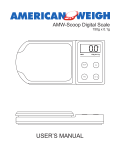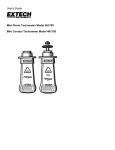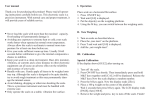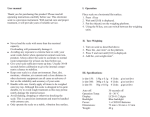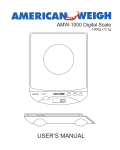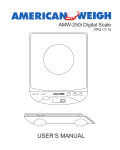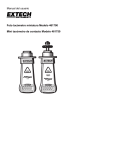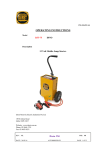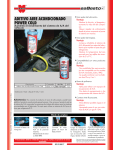Download USER`S MANUAL - American Weigh Scales Inc
Transcript
AMW - Card 250g x 0.1g TM g TARE MODE ON/OFF USER’S MANUAL American Weigh Scales Card Scale User’s Manual 250 x 0.1g Thank you for purchasing the American Weigh Card Scale. Please read all operating instructions carefully before use. This electronic scale is a precision instrument. Weith normal care and proper treatment, it will provide years of reliable service. • Never load the scale with more than the maximum capacity. • Avoid any exposure to extreme heat or cold. Your scale will work better when operated at normal room temperature. Always allow the scale to acclimate to surrounding temperature for at least one hour before use. • Give your scale sufficient warm up time. Usually 30-60 seconds before calibration to give the internal components a chance to stabilize. • Keep your scale in a clean environment. Dust, dirt, moisture, vibration, air currents, and a close proximity to other electronic devices can cause an adverse effect on the reliability and accuracy of your scale. • Handle with care. Gently apply all items to be weighed onto tray top. Although this scale is designed to be quite durable, try to avoid rough treatment which can permanently damage the internal sensor. • Avoid shaking, dropping, or otherwise shocking the scale. This is a precision instrument and must be handled with extreme care. •Only operate the scale on a stable, vibration free surface. I. Operation Place the scale on a horizontal flat surface. 1. Press ON/OFF key. 2. Wait until [0.0] is displayed. 3. Put the object(s) on the weighing platform. 4. Using the MODE key, you can switch between the weighing units. II. Tare Weighing. 1. Turn on scale as described above. 2. Place the “tare item” on the platform. 3. Press TARE and wait until [0.0] is displayed. 4. Add the “net-weight-item”. III. Calibration Special Calibration- If the display shows [OUE2] after turning on: 1. Turn OFF the scale. 2. Press ON/OFF key briefly then immediatley press and hold the MODE and TARE buttons simultaneously until [CAL] is displayed. Release the MODE and TARE buttons and a random internal statement number will be displayed. 3. Press the MODE key once and the display will show [2Ero]. 4. Place a 200g weight on the center of the platform. Wait 2 seconds then press MODE key again. The LCD will display [PASS] then [200.0]. 5. Remove the weight and turn off the scale. Special Calibration is complete. Standard Calibration: 1. Turn OFF the scale. 2. Press ON/OFF key briefly then then press and hold MODE key until [CAL] is displayed. Release the MODE key. 3. Press MODE key again and the display will show [CAL] then [200.0] will flash 3 times. 4. Place a 200g weight on the center of the platform. Wait 3-4 seconds. The LCD will display [PASS] then [200.0]. 5. Remove the weight and press ON/OFF to turn off the scale. Standard Calibration is now complete! Repeat this process if the scale does not operate properly. Calibration weights should be available wherever you purchased the scale. IV. Specifications Capacity: 250 g / 8.82 oz / 160.8 dwt / 8.04 ozt Readability: 0.1 g / 0.01 oz / 0.1 dwt / 0.01 ozt Units: g (grams) / oz (ounces) / dwt (pennyweights) / ozt (troy ounce) Tare Range: Tare to full capacity Auto Off: 30 seconds Backlight: Blue backlight Power: 2 x CR2032 Batteries Dimensions: 3.9” (l) x 3” (w) x 0.5” (h) Weight: 114g V. Troubleshooting The primary reason for innaccuracy or malfunction are low batteries, incorrect calibration, overload or operating on an unstable surface. Please keep this in mind and maintain and operate your scale properly. The scale is a precise instrument and must be handled with care. Error Code Descriptions: Error: Nothing, Battery-Symbol, [lo] or [88888] Solution: Replace Batteries Error: [OUE2] Solution: Recalibrate the scale using the Special Calibration method described in Section III. Error: [OLD] Solution: You are overloading the scale. Remove excessive load immediately. Error: [LLLLL] Solution: The delicate load cells have been damaged by misuse (i.e. It was shocked, dropped, or overloaded). You can try to recalibrate the scale. If the load cell is not too damaged, it will work again after recalibration. Error: [UNST] Solution: Use the scale on a more stable surface / area.






